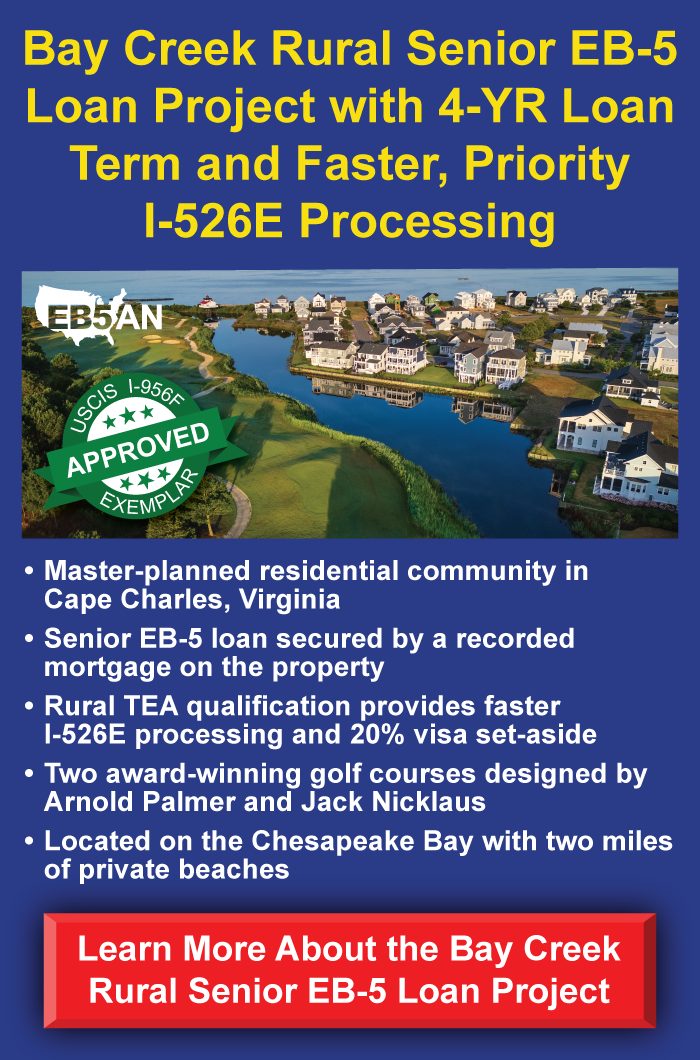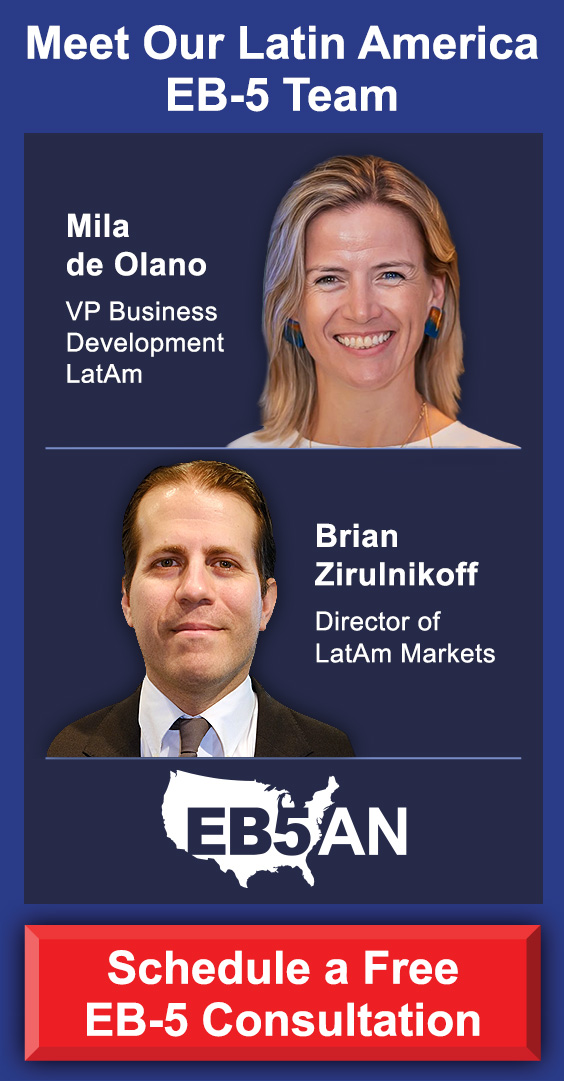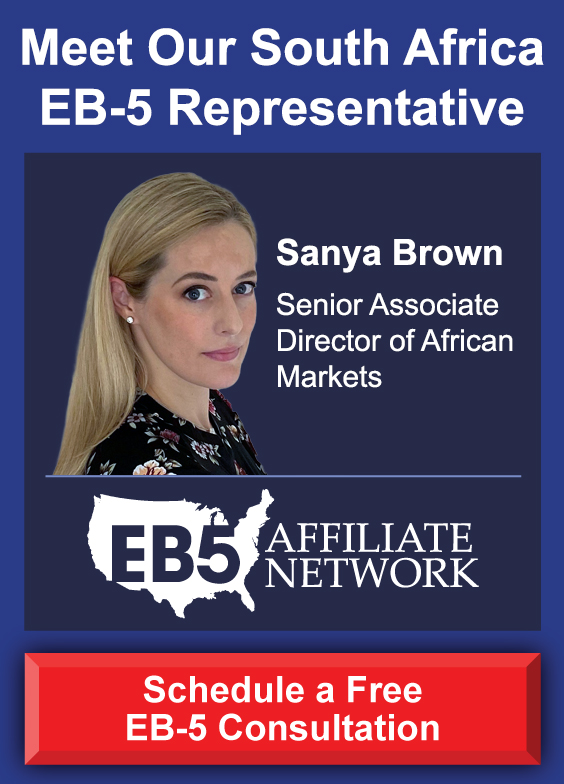Are you living in the United States on an H-1B, or a similar visa, and looking for a permanent solution that doesn’t depend on your employer? Or are you abroad and want a fast, direct path to a U.S. Green Card?
In 2025, the EB-5 Immigrant Investor Program offers a clear path to these goals. Many investors are seeing work and travel authorization within weeks or a few months after filing—and some are receiving their Green Card in only a few months.
EB5AN is pleased to release a new video covering all of the steps to get started on the EB-5 process in 2025 and secure immigration benefits as quickly as possible.
This guide explains how EB-5 works today: who should consider it, what the process looks like from initial research to permanent Green Card, how to manage both immigration and financial risk, and why the choice between rural and urban projects can significantly affect your timeline.
EB5AN’s mission is to help investors make well-informed decisions. Since 2013, we’ve helped more than 2,700 families from over 70 countries begin the EB-5 journey. Our projects have maintained a 100% USCIS project approval rate, and many of our investors already hold permanent Green Cards. If you decide EB-5 is right for you, you can schedule a free consultation to discuss options and next steps.
To complement our video guide, we’ve prepared the following blog post that summarizes the key steps of the EB-5 process and how you can get started today.
Who Should Consider EB-5—and Why 2025 Is Different
The EB-5 Process, Step by Step
Keeping your Capital and Immigration Goals Safe
Rural vs. Urban TEA Projects: Timelines, Set-Asides, and Strategy
Next Steps
Who Should Consider EB-5—and Why 2025 Is Different
EB-5 is especially compelling if you are already in the United States on visas such as H-1B, E-2, F-1, or TN and want to remove the uncertainty tied to employment, sponsorship, or student status. Consider a typical H-1B scenario: a layoff can force abrupt decisions about status and departure. EB-5, by contrast, provides a route to permanent residency that is not dependent on a continuing job offer or a specialty occupation.
If you file EB-5 while maintaining valid status, you can generally remain in the U.S. while your petition is pending. With concurrent filing, many applicants obtain an Employment Authorization Document (EAD) and Advance Parole (AP) shortly after submission—enabling continued employment (for any employer), entrepreneurship, and international travel.
EB-5 can also be the fastest option if you live outside the U.S. Unlike categories that depend on exceptional ability or employer sponsorship, EB-5 is based on a qualifying investment and job creation. Your spouse and unmarried children under 21 can be included under the principal investor’s case, giving your family a unified path.
And many investors in EB5AN’s rural projects are gaining their USCIS approvals in only months.
Core requirements for EB-5
The EB-5 program requires a qualifying investment—$800,000 in a project located in a Targeted Employment Area (TEA), often a real estate development. U.S. law prohibits any guarantee of return; this is a bona fide investment that carries risk. However, careful project selection can materially reduce that risk. Equally important is documenting the lawful source and path of funds. You and your immigration attorney will compile evidence (salary history, business profits, loan documents, gifts, sales proceeds, tax filings, bank records, and transfer proofs) to show USCIS that your capital is legitimate and traceable.
If your goal is a Green Card, you can document lawful capital, and you are comfortable making an at-risk investment, consider making an EB-5 investment in 2025.
The EB-5 Process, Step by Step
The full EB-5 journey spans several stages. You may receive interim benefits quickly, but plan on a multi-year process from investment to permanent residency.
Step 1: Contact EB5AN and Review Your Eligibility
Contact EB5AN to get started. You’ll complete a short investor questionnaire about your background and financial profile, then sign a confidentiality agreement so you can receive the investment materials. EB5AN will send you the project summaries and offering documents.
Read each section carefully—review the investment amounts, project timeline, developer history, and risk disclosures. If something isn’t clear—such as the TEA designation or any projected returns—you can always contact us or your immigration attorney.
Step 2: Select Your EB-5 Project
Every EB5AN project qualifies as a targeted employment area, or TEA, which means you can invest $800,000 instead of the higher non-TEA amount of $1,050,000.
A TEA is either a rural area—outside any metro area or municipality containing over 20,000 people—or an urban area where the unemployment rate is at least 150 percent of the national average.
Selecting the right project requires careful due diligence. You should review each project’s location, stage of construction, developer track record, and projected returns. Think about what matters most to you—speed of construction, local market fundamentals, or projected cash flow—and pick the project that best matches your goals and risk profile.
Step 3: Compile Your Source-of-Funds Documentation
To prove that your funds came from legal means, USCIS requires very detailed source-of-funds documentation for your investment. Working with your immigration attorney is vital to make sure you gather all the documents that trace your capital back to its source. These documents will vary depending on how you sourced the capital—be it a loan, salary payments, gifted funds, etc.
This can be one of the most challenging steps for EB-5 investors. We highly recommend choosing an immigration attorney who’s experienced, especially in working with funds from your country of origin, and has a strong record of USCIS approvals.
Step 4: Complete and Sign the Subscription Agreement and Wire Your Funds
Next, you’ll fill out and sign the subscription booklet. EB5AN provides clear instructions to make this quick and accurate.
Once you complete the subscription agreement, EB5AN will review and countersign, then send you a fully executed copy.
This is one of the key documents you’ll include with your USCIS petition. After completing it, you’ll be ready to wire your $800,000 investment.
Step 5: File Form I-526E, Immigrant Petition by Regional Center Investor
Once you have wired your funds to escrow and all your paperwork is in order, your attorney will assemble your I-526E petition. This package includes your source-of-funds report, subscription agreement, evidence of TEA qualification, project documents, and any support letters from EB5AN.
When USCIS receives your I-526E petition, it issues a receipt notice that includes your priority date. That priority date secures your place in the visa queue. Keep the receipt number handy so you can monitor your case status online.
Step 6: EAD, APs, and Your Conditional U.S. Green Card
If you’re already in the U.S. on a valid visa—such as an H-1B, E-2, F-1, or TN—you can file Form I-485 concurrently with Form I-526E. Filing Form I-485 concurrently allows you to remain in the U.S. while your application is pending.
At this time, you may also apply for an employment authorization document, or EAD, and an advance parole, or AP, travel permit by filling Forms I-765 and I-131. Many investors receive approval for this authorization within weeks or a few months.
After USCIS approves your I-526E petition, you move on to obtaining your two-year conditional Green Card.
If you already live in the U.S., USCIS will adjust your immigration status to “conditional permanent resident” and send you your Green Card.
If you’re abroad, you’ll go through consular processing. For this process, you will submit Form DS-260, complete a medical exam, collect civil documents, and attend your interview at the U.S. embassy or consulate.
Step 7: File Form I-829 and Receive Your Permanent Green Card
Within 90 days before your conditional Green Card expires, your attorney will file Form I-829 to remove the conditions on your Green Card. That petition must show that your capital stayed invested and that the project used your funds to create at least 10 jobs for American workers.
Once your I-829 is filed, depending on the terms of the investment, the project can repay your funds plus any returns. This is particularly helpful for investors since USCIS’s review of your I-829 can take several months or years.
Once your I-829 is approved, you’ll receive a 10-year permanent Green Card.
Keep in mind that you can stay in the U.S. until USCIS processes your I-829. During this time, EB-5 investors can get extensions on their conditional Green Cards, so you won’t have to leave the country.
Keeping your Capital and Immigration Goals Safe
EB-5 involves two kinds of risk you should be aware of.
Immigration risk relates to USCIS approval—of the project and the investor. The project must be compliant and must create sufficient jobs. Your I-526E submission must clearly establish the lawful source and path of funds.
Financial risk reflects the reality that EB-5 investments are at risk and cannot be guaranteed to result in a return of your funds. Your objective is to reduce financial risk while maintaining compliance with EB-5 rules.
Choosing a strong EB-5 regional center is key to mitigating both categories. A USCIS-designated regional center sponsors projects and typically partners with the investment manager. The center tracks job creation, prepares economic analyses, oversees compliance documentation, and coordinates with counsel.
When you choose an experienced regional center with a disciplined underwriting approach—and you choose a project with a clear business plan, credible job creation, prudent leverage, and real protections (e.g., collateral, completion support, cash controls, third-party administration)—you improve the likelihood of both immigration and financial success.
Key items to evaluate before investing in any EB-5 project:
- Capital stack and collateral: seniority of the EB-5 position, lien structure, equity cushion, and the presence (and form) of any completion support.
- Job creation cushion: projected job creation materially above the minimum required per investor.
- Construction and disbursement controls: independent fund administration, cost-to-complete analysis, and staged draws tied to verified progress.
- Developer record: history delivering similar projects on time and on budget, with direct experience in the specific asset class and market.
- Transparency and reporting: regular investor updates and accessible data rooms.
Rural vs. Urban TEA Projects: Timelines, Set-Asides, and Strategy
In 2025, one of the most crucial strategic choices for EB-5 investors is whether to pursue a rural or urban TEA project. Both qualify for the $800,000 threshold, but can have significantly different immigration timelines.
Reserved (set-aside) visas
Each fiscal year, a fixed share of EB-5 visas is reserved for TEA investments: 20% for rural projects and 10% for high-unemployment urban projects. These reserved categories sit alongside the unreserved pool. For investors from countries with heavy EB-5 demand—currently including China and India in the unreserved category—reserved visas can help you avoid retrogression (visa backlogs) of months or even many years.
Priority processing for rural
USCIS has assigned priority processing to rural I-526E petitions. In practice, this has translated into notably faster adjudications for many rural filings. EB5AN has seen rural approvals arrive in a matter of months, with some investors who filed concurrently receiving EAD/AP even earlier. While timelines are never guaranteed and can vary, the empirical trend has been clear: rural filings move more quickly on average than urban filings.
Urban set-asides are limited
Because urban reserved visas represent 10% of the annual allocation (versus 20% for rural), the urban set-aside supply may become constrained sooner if demand spikes, particularly from backlogged nationalities. If that occurs, investors relying on the urban reserved category could face longer waits than their rural counterparts.
How to choose between rural and urban
Your selection should be grounded in whether your country of birth has a visa backlog and your goals regarding immigration speed and risk.
- If you are from China or India and time is critical, a rural project often offers the best chance at a faster path due to both the larger reserved allocation and priority processing.
- If you are not from a backlogged country, and you have identified an urban opportunity that matches your risk and return goals, urban could still be a viable option—especially if you plan to file concurrently, obtain EAD/AP, and are comfortable awaiting I-526E approval while living and working in the U.S.
- EB5AN sponsors both rural and urban projects because investors’ needs differ. The “right” choice is the project that best aligns with your immigration timeline, capital-preservation priorities, and personal situation.
Next Steps
- Start gathering your source of funds. Begin gathering bank statements, tax returns, employment or business records, sale agreements, loan documents, and gift or inheritance papers. A clear, traceable record is one of the strongest predictors of a smooth case.
- Decide rural vs. urban. If you need the fastest practical path and you’re from a high-demand country, rural’s reserved visas and priority processing often make it the preferred route. If you are not facing backlogs and an urban project better fits your investment goals, weigh that option carefully.
- Speak with EB-5 professionals. Choose an immigration attorney experienced with EB-5 and with source-of-funds norms in your home country. Ask regional centers for detailed project documents, economic studies, and fund-administration arrangements.
- Set a practical timeline. While interim benefits may arrive quickly, approach EB-5 as a multi-year plan that culminates with I-829 approval and permanent residency.
Since 2013, EB5AN has helped thousands of families start—and many to complete—this journey. We will walk you through the documents, answer your questions, and help you align project selection with your immigration and financial goals. Schedule a free consultation to review options tailored to your situation









